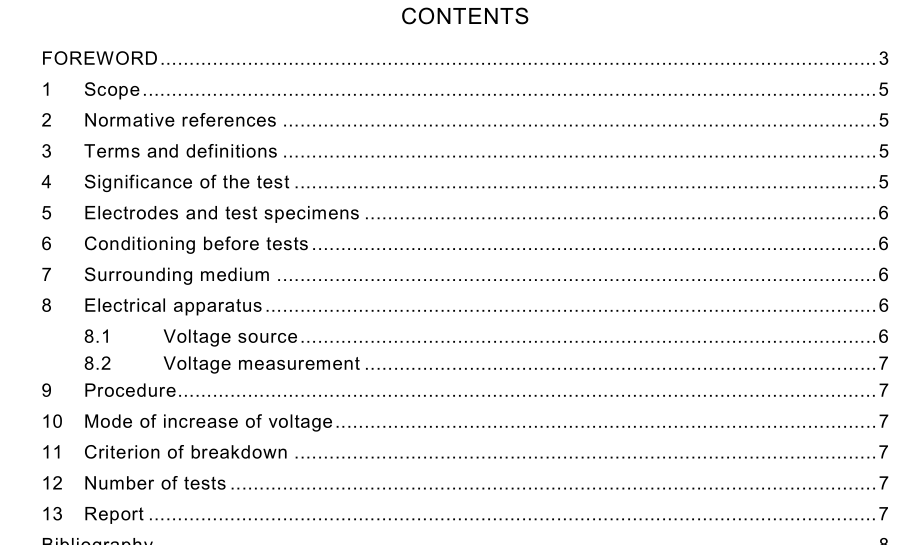IEC 60243-2-2013 pdf Electric strength of insulating materials – Test methods – Part 2: Additional requirements for tests using direct voltage

8 Electrical apparatus 8.1 Voltage source The test voltage applied to the electrodes shall be provided by a power supply having the following characteristics and components. A choice of voltage of either positive or negative polarity shall be provided, one of the connections to the electrodes being earthed. The voltage ripple on the test voltage shall not exceed 2 % of the voltage at all values greater than 50 % of the breakdown voltage. The test voltage shall also be free from transients or other fluctuations exceeding 1 % of the applied voltage. When testing test specimens of low capacitance, it may be necessary to add a suitable capacitor (for example, 1 000 pF) in parallel with the electrodes in order to reduce the influence of transients in initiating premature breakdowns. The controls on voltage shall be capable of varying the test voltage smoothly and uniformly between zero and the maximum test voltage and with the requested rate of voltage rise. The rate of voltage rise shall be controllable within ±20 % of the specified rate. Steps in voltage rise shall not exceed 2 % of the expected breakdown voltage value. Controls which automatically increase the voltage at a selectable rate are preferable. A current-sensitive interrupting device shall be used for switching off the direct voltage source. For many materials, a dangerous voltage may persist across the test specimen for a considerable time after the d.c. test voltage is removed. Disconnection of the power supply to the direct voltage source does not necessarily result in the output voltage or the voltage at the electrodes being reduced to zero. For this reason, it is essential that the electrodes be short- circuited and connected to earth for a period equal to minimum twice the total charging time to ensure that the charge is dissipated. For some large test specimens it will be necessary to maintain the shorted condition for 1 h or even longer.
- ISO IEC 27050-4-2021 pdf Information technology — Electronic discovery — Part 4: Technical readiness
- ISO IEC 27036-1-2021 pdf Cybersecurity — Supplier relationships — Part 1: Overview and concepts
- ISO IEC 27013-2021 pdf Information security, cybersecurity and privacy protection — Guidance on the integrated implementation of ISO/IEC 27001 and ISO/IEC 20000-1
- ISO IEC 26580-2021 pdf Software and systems engineering — Methods and tools for the feature- based approach to software and systems product line engineering
- ISO IEC 24735-2021 pdf Information technology — Office equipment — Method for measuring digital copying productivity
- ISO IEC 24711-2021 pdf Information technology — Office equipment — Method for the determination of ink cartridge yield for colour inkjet printers and multi- function devices that contain printer components
- ISO IEC 23544-2021 pdf Information Technology — Data centres — Application Platform Energy Effectiveness (APEE)
- ISO IEC 23510-2021 pdf Information technology — 3D printing and scanning — Framework for an Additive Manufacturing Service Platform (AMSP)
- ISO IEC 23127-1-2021 pdf Information technology — Learning, education, and training — Metadata for facilitators of online learning — Part 1: Framework
- ISO IEC 23126-2021 pdf Information technology for learning, education and training — Ubiquitous learning resource organization and description framework
- IEC 61251-2015 pdf Electrical insulating materials and systems – AC voltage endurance evaluation
- BS IEC 62843-2013 pdf Standard for N times 64 kilobit per second optical fiber interfaces between teleprotection and multiplexer equipment
- IEC 62271-112-2013 pdf High-voltage switchgear and controlgear – Part 112: Alternating current high-speed earthing switches for secondary arc extinction on transmission lines
- BS IEC 60860-2014 pdf Radiation protection instrumentation一 Warning equipment for criticality accidents
- IEC 60305-2021 pdf Insulators for overhead lines with a nominal voltage above 1 000 V – Ceramic or glass insulator units for AC systems – Characteristics of insulator units of the cap and pin type
- BS ISO IEC 15420-2009 pdf Information technology一 Automatic identification and data capture techniques EAN/UPC bar code symbology specification
- BS ISO IEC 19762.5-2008 pdf Information technology一 Automatic identification and data capture (AIDC) techniques – Harmonized vocabulary Part 5: Locating systems
- BS IEC 60860-2014 pdf Radiation protection instrumentation一 Warning equipment for criticality accidents
- ISO IEC 24735-2021 pdf Information technology — Office equipment — Method for measuring digital copying productivity
- ISO IEC 24711-2021 pdf Information technology — Office equipment — Method for the determination of ink cartridge yield for colour inkjet printers and multi- function devices that contain printer components